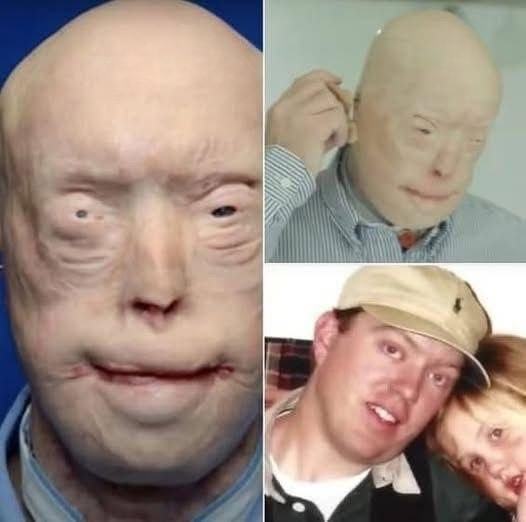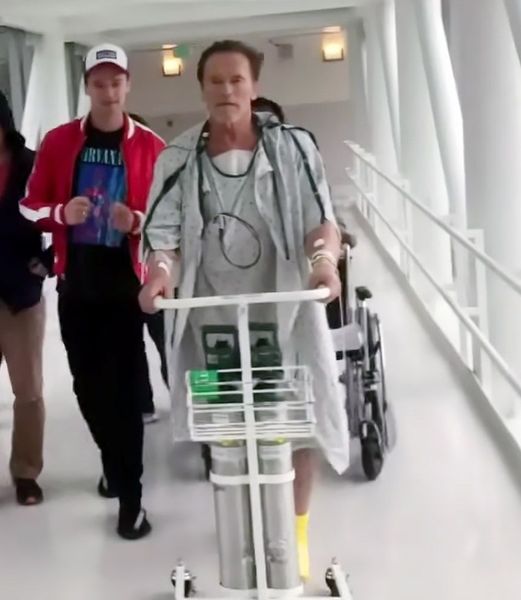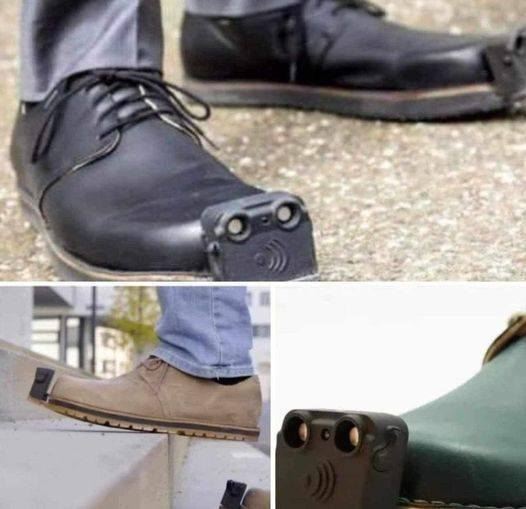A Hero’s Devotion and a Life-Altering Event
In 2001, Patrick Hardison, a volunteer firefighter from Senatobia, Mississippi, exemplified the courage and commitment of first responders across the nation. Responding to a fire at a residential home, he believed a woman was trapped inside and acted without hesitation. This instinct to help, characteristic of someone dedicated to saving lives, set the stage for an event that would profoundly alter the course of his own life.
When Patrick entered the burning house, the structure unexpectedly collapsed. Flames engulfed him, and the intensity of the fire caused third-degree burns over his face, scalp, neck, and upper chest. Key facial features—ears, lips, eyelids, and his nose—were destroyed, leaving him unrecognizable. While emergency medical teams worked tirelessly to stabilize him, Patrick’s injuries were catastrophic, setting in motion a long and challenging journey of physical recovery and emotional resilience.
This tragedy not only transformed Patrick’s appearance but also reshaped his identity and day-to-day life. The journey ahead would demand extraordinary perseverance, the unwavering support of loved ones, and the advancement of groundbreaking medical science.
Life in Hiding: The Emotional Toll of Disfigurement
For years after the fire, Patrick lived behind protective shields. Baseball caps, sunglasses, and prosthetic ears became his daily armor. This was not simply a matter of preference but a necessity, as the public often reacted with shock or discomfort. Patrick has shared that children would sometimes scream upon seeing him, a reaction that carried a heavy emotional burden.
Simple activities such as eating in public, smiling, or seeing his own reflection became emotionally challenging. These moments reminded him of the life he had lost, compounding feelings of isolation and depression. Yet amid these hardships, Patrick found solace and strength in his family. The love of his children served as a constant motivation, reinforcing his desire to continue despite the challenges.
Patrick’s wife, Chrissi, provided unwavering support through dozens of surgeries, skin grafts, and attempts at facial reconstruction. Even after years of medical intervention, scar tissue remained tight, restricting facial movement, blinking, and speech. The scars were more than physical—they shaped Patrick’s interactions with the world and influenced his perception of self-worth and identity.
A Glimmer of Hope: The Promise of Medical Innovation
After over a decade living with disfigurement, Patrick’s life changed again in 2015. Doctors at NYU Langone Medical Center offered him the opportunity to undergo a full-face transplant, a procedure that was among the most ambitious attempts ever conducted in the United States. The surgery promised not only a restoration of appearance but also the recovery of essential facial functions, including blinking, speaking, smiling, and breathing.
The proposed operation involved transplanting donor tissue, including scalp, ears, eyelids, nose, lips, and all facial skin. The risks were significant—a fifty percent chance of survival—but Patrick was determined. “I had nothing left to lose,” he said. “I wanted to walk into my kids’ school without scaring anyone.” His decision exemplified both courage and hope, reflecting the human desire to reclaim dignity and normalcy.
The Complexity of a Full-Face Transplant
In August 2015, a team of more than 100 medical professionals, led by Dr. Eduardo Rodriguez, embarked on a 26-hour surgical procedure. The operation required the coordination of two synchronized surgical teams: one prepared the donor tissue while the other prepared Patrick for the transplant. Each artery, vein, nerve, and muscle was meticulously attached to restore function as well as appearance.
The procedure was unprecedented in its complexity. Surgeons had to carefully connect facial nerves to ensure Patrick could regain the ability to move his lips, blink naturally, and express emotions. Every step required precision; a single miscalculation could result in life-threatening complications. Despite the enormous risks, Patrick’s optimism and resolve fueled both him and the medical team throughout the long procedure.
https://googleads.g.doubleclick.net/pagead/ads?gdpr=0&gdpr_consent=CQYWmsAQYWmsAEsACBENB-FgAAAAAEPgACaIAAAR2QD-F2I2EKFEHCuQUYIYBCuACAAxYBgAAwCBgAAGCQgQAgFJIIkCAEAIEAAEAAAQAgCAABQEBAAAIAAAAAqAACAABgAQCAQQIABAAAAgIAAAAAAEQAAIgEAAAAIAIABABAAAAQAkAAAAAAAAAECAAAAAAAAAAAAAAAAAAAAAEABgAAAAAABEAAAAAAAACAQIAAA&addtl_consent=2~~dv.61.89.122.184.196.230.314.442.445.494.550.576.827.1029.1033.1046.1047.1051.1097.1126.1166.1301.1342.1415.1725.1765.1942.1958.1987.2068.2072.2074.2107.2213.2219.2223.2224.2328.2331.2387.2416.2501.2567.2568.2575.2657.2686.2778.2869.2878.2908.2920.2963.3005.3023.3100.3126.3219.3234.3235.3253.3309.3731.6931.8931.13731.15731.33931&client=ca-pub-8681813503854240&output=html&h=280&adk=809345383&adf=3954104042&w=651&fwrn=4&fwrnh=100&lmt=1762030638&rafmt=1&armr=3&sem=mc&pwprc=6356162351&ad_type=text_image&format=651×280&url=https%3A%2F%2Faliacar.net.tr%2F2025%2F11%2F01%2Fpatrick-hardison-from-firefighter-tragedy-to-a-groundbreaking-medical-miracle%2F&fwr=0&pra=3&rh=163&rw=650&rpe=1&resp_fmts=3&wgl=1&fa=27&uach=WyJXaW5kb3dzIiwiMTkuMC4wIiwieDg2IiwiIiwiMTQxLjAuMzUzNy45OSIsbnVsbCwwLG51bGwsIjY0IixbWyJNaWNyb3NvZnQgRWRnZSIsIjE0MS4wLjM1MzcuOTkiXSxbIk5vdD9BX0JyYW5kIiwiOC4wLjAuMCJdLFsiQ2hyb21pdW0iLCIxNDEuMC43MzkwLjEyMyJdXSwwXQ..&abgtt=6&dt=1762030620899&bpp=1&bdt=812&idt=1&shv=r20251029&mjsv=m202510280101&ptt=9&saldr=aa&abxe=1&cookie=ID%3Dc0f3e4fda2911ebd%3AT%3D1758829351%3ART%3D1762030616%3AS%3DALNI_MbUnczZdCJatGPIuXgucjS5inrLXQ&gpic=UID%3D00001153a99c2cd0%3AT%3D1758829351%3ART%3D1762030616%3AS%3DALNI_MZxdUMQvkGMYlB4T8QpvYOmKo_JxQ&eo_id_str=ID%3D327bbffc1130b9e4%3AT%3D1758829351%3ART%3D1762030616%3AS%3DAA-AfjY4F2DuGpVSSbvshYenNtWz&prev_fmts=0x0%2C1110x280%2C651x280%2C651x280%2C651x280%2C651x280%2C651x280%2C651x280%2C651x280%2C651x280%2C651x280%2C651x280&nras=13&correlator=3093750101632&frm=20&pv=1&u_tz=60&u_his=4&u_h=720&u_w=1280&u_ah=672&u_aw=1280&u_cd=24&u_sd=1.5&dmc=8&adx=113&ady=3646&biw=1257&bih=594&scr_x=0&scr_y=1287&eid=31095515%2C31095559%2C31095566%2C31095569%2C95344789&oid=2&psts=AOrYGskJAXoBc-mwjnvIU90fxAJV22mTPxEcx_IpMPYJoneeU2k4la3iFvv5tNS5jAbGwpSEe58ttq8mdjU0lMq9eDmPFmuWCoFwTT771wbD2QHQ%2CAOrYGsk70d2B7nCF-_1CtthO5ujo7sN4fNxoCEAhfvTpXqVFiRm4XaXUcri6N_aOo8zCun62adNeFq1lASQ97bs6jR-DXj_7Yx4HlVJUC3Ulii8&pvsid=3746967721854006&tmod=716222848&uas=3&nvt=1&ref=https%3A%2F%2Faliacar.net.tr%2F%3Fs%3DPatrick%2BHardison%253A%2BFrom%2BFirefighter%2BTragedy%2Bto%2Ba%2BGroundbreaking%2BMedical%2BMiracle%26fbclid%3DIwY2xjawNzU2ZleHRuA2FlbQIxMAABHktV8TbHU3z_Ytm12_8ZqjedOJuZ-dV1y4os-RcweE3E1Qka65ppsZ5L9hHF_aem_1ikXiTWwQVrdX47rFBV9PQ&fc=1408&brdim=0%2C0%2C0%2C0%2C1280%2C0%2C1280%2C672%2C1272%2C594&vis=1&rsz=%7C%7Cs%7C&abl=NS&fu=128&bc=31&bz=1.01&td=1&tdf=2&psd=W251bGwsbnVsbCxudWxsLDNd&nt=1&pgls=CAEaBTYuOC4z&num_ads=1&ifi=13&uci=a!d&btvi=11&fsb=1&dtd=17950
Upon waking, Patrick experienced the warmth and texture of his new face. Weeks later, looking into a mirror, he saw more than a reconstructed face; he saw a renewed sense of possibility, a tangible manifestation of hope and medical innovation.
The Long Road to Recovery
Recovery from the transplant was extensive and multifaceted. Patrick had to relearn basic facial functions, including how to blink naturally, speak clearly, and express emotions. Physical therapy and rehabilitation were essential components of this process, as were frequent medical evaluations to monitor the body’s response to the donor tissue. Immune-suppressant medications were required to prevent rejection, adding another layer of complexity to his recovery.
Gradually, Patrick regained abilities he had lost for 14 years. He could breathe freely, eat without assistance, and interact with others without fear. This newfound functionality allowed him to reenter public life with confidence, engaging with his community and participating in activities with his children. For the first time in over a decade, Patrick was able to live without hiding, and people could see him as the person he had always been rather than as a victim of a tragic accident.
Human Connection Behind the Surgery
The donor, 26-year-old David Rodebaugh, had tragically passed away in a cycling accident. Patrick later met David’s mother, Nancy Millar, expressing his profound gratitude for the life-saving gift. “Your son saved me,” he said through tears. This encounter underscored the human dimension of medical advancement, highlighting the generosity and compassion that made Patrick’s second chance at life possible.
The story of donor families is often overlooked in discussions of transplantation. In Patrick’s case, the courage and kindness of David’s family became intertwined with the groundbreaking medical achievement, illustrating how human empathy and scientific innovation can work hand-in-hand to save lives.
Patrick Hardison Today: A Symbol of Resilience
Seven years after the surgery, Patrick’s new face has settled naturally. His bright blue eyes, restored eyelids, and genuine smile reflect not only surgical success but also his resilience and determination. Patrick actively participates in community events, attends his children’s activities, and shares his story with burn survivors and transplant patients around the world.
Patrick encourages others to persevere, emphasizing that even in moments of despair, hope exists. “Don’t give up on yourself,” he says. “There’s always hope, even when you can’t see it.” His words resonate with anyone facing personal or medical challenges, reinforcing the idea that courage, determination, and support can overcome even the most difficult circumstances.
The Broader Impact on Medicine and Society
Patrick Hardison’s story represents a milestone in reconstructive surgery, inspiring advancements in facial transplants and burn treatment worldwide. His case has contributed to the refinement of surgical techniques, rehabilitation strategies, and postoperative care for patients undergoing complex transplants. Moreover, his journey has increased public awareness of the importance of organ donation, inspiring others to register as donors and save lives.
Facial reconstruction and transplantation are among the most challenging areas of modern medicine. They require an intricate understanding of anatomy, immunology, and surgical precision, as well as a multidisciplinary approach involving surgeons, therapists, psychologists, and support staff. Patrick’s successful recovery demonstrates the potential of these procedures to restore both function and dignity to patients who have suffered catastrophic injuries.
An Inspirational Legacy
Patrick’s journey extends beyond the physical transformation of his face. It embodies resilience, hope, and the power of the human spirit to overcome adversity. His experience serves as a beacon for burn survivors, trauma patients, and anyone facing seemingly insurmountable obstacles.
Through advocacy and public engagement, Patrick raises awareness of medical possibilities while emphasizing the emotional and social aspects of recovery. He highlights the importance of family, community support, and the generosity of organ donors in shaping outcomes. His story illustrates that healing is not solely a medical process but also a deeply human one, rooted in empathy, love, and determination.
The Human Element of Healing
Patrick’s recovery reminds us that medical miracles are intertwined with human compassion. Every transplant depends not only on surgical expertise but also on the willingness of donor families to give the gift of life. Patrick’s life today reflects this profound connection, showing how courage, science, and generosity can combine to transform tragedy into opportunity.
Beyond surgery, Patrick’s personal growth and advocacy work have had lasting effects. He inspires others to confront challenges with optimism, demonstrating that adversity can catalyze resilience and meaningful change. His message encourages society to recognize the potential in each individual to overcome setbacks and reclaim their lives, regardless of the obstacles faced.
From Tragedy to Triumph
Patrick Hardison’s journey is a story of courage, innovation, and human resilience. From the devastating fire in 2001 to the pioneering full-face transplant in 2015, he has navigated unimaginable physical and emotional challenges. Today, he lives as a symbol of hope, demonstrating what is possible when science, compassion, and determination intersect.
Every morning, Patrick wakes to see his children, feel the sun on his face, and embrace the life he fought so hard to regain. His story proves that even in the darkest moments, recovery and transformation are possible. Through his experiences, Patrick embodies the triumph of the human spirit and the enduring impact of medical innovation.
Conclusion: A Lasting Message of Hope
Patrick Hardison’s life reflects a powerful lesson: tragedy does not define us, but our response to it does. His journey underscores the potential of modern medicine, the importance of organ donation, and the resilience inherent in the human spirit. By sharing his story, Patrick continues to inspire countless individuals worldwide, reminding us that hope, courage, and perseverance can overcome even the most daunting challenges.
From the ashes of a devastating fire emerged a man whose life symbolizes the power of recovery, compassion, and scientific achievement. Patrick Hardison’s legacy is more than a medical milestone—it is a testament to the ability of the human spirit to heal, adapt, and thrive.



